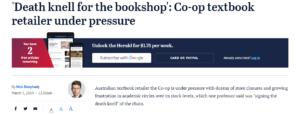Bardot Collapse – 3 Valuable Lessons for Retail
Share

It’s a sad day when another iconic Australian Retail Fashion Brand, Bardot, goes into administration with the potential loss of 800 jobs and the closure of 72 stores. It was also a bad week with the Co-op Bookshop going into administration with 34 Co-op stores and 63 Curious Planet stores with the potential loss of over 400 jobs.
When businesses go into administration more often the assets are sold off and the brand disappears, on the rare occasion when they are sold on, it is often as a slimmed-down operation, Oroton is a good example of a retailer that survived the administration process, most do not.
Lesson 1: Read the Early Warning Signs:
Retail businesses do not go broke overnight, there are early warning signs 2 or 3 years before. These signs include declining sales, gross margin and net profitability, increasing aged stock and decreasing/low stock turns, tight cash flows, unprofitable stores, declining store visits, and transaction counts.
 Often these warning signs can be in the public domain either in financial statements of Public Companies or in the media for example on March 5, 2019, the Sydney Morning Herald Journalist Nick Bonyhady wrote an article ‘Death knell for the bookshop’: Co-op textbook retailer under pressure’ it took another 9 months for the administrators to be appointed.
Often these warning signs can be in the public domain either in financial statements of Public Companies or in the media for example on March 5, 2019, the Sydney Morning Herald Journalist Nick Bonyhady wrote an article ‘Death knell for the bookshop’: Co-op textbook retailer under pressure’ it took another 9 months for the administrators to be appointed.
When we work with retailers, we always start by reviewing 3 years of data and interviewing senior managers to identify the issues and where the savings are or growth opportunities. For example, a common problem is aged/overstock which reflects in low stock turns, one retailer we recently were working with has a $1.5m excess stock, 2.2 stock turns versus the industry average of 3.5) and bank debt of $1m. We put in place a strategy to clear the stock, pay down the debt and improve the buying function. Nine months later it is 80% of the way to resolution.
Lesson 2: Set in Place A Transformation Strategy that Executives are Accountable For.
If things are tough then senior management needs to put in place a transformation strategy that is designed to transform the business and set Sales/Margin/Net Profitability/Stock/Cash Flow/Plan Delivery targets they are accountable for and that owners and shareholders can measure them against at least every 3 months
Seek outside help to put this together, the plan should take no more than 6 weeks. Why outside help, well the team that gets the business into trouble is often too timid, too under pressure or too invested in the current strategy to make the drastic changes that are needed.
Lesson 3: Don’t Blame the Economy, The Competition, Amazon, Landlords, Electricity prices, Government, E-commerce, The Weather…
Basil Artemides the CEO of Bardot said on Thursday that operating a national retail network in its current state was “no longer sustainable”… “Bardot’s retail stores in Australia are competing in a highly cluttered, and increasingly discount-driven market,”
I am not sure I agree with Basil here, as there are many successful and profitable retailers prospering today in this environment, for example, The Just Group to name one of many. I am not a fan of blaming things outside of your control such as the competitors the economy etc, what is inside your control is the business and the levers you can adjust to grow the business now. That’s Lesson 3.
Summary
Successful retailers have recognized changing buyer behaviour and demographics the value of data and analytics in decision making, customer experience and have made significant changes to their business model to stay ahead.
Retailers that are struggling do not read the early warning signs are vested in traditional retail structures and past successes and find it difficult to enact meaningful change mistaking tactical project and a minor adjustment to their business for a transformation strategy


















Follow us on social media